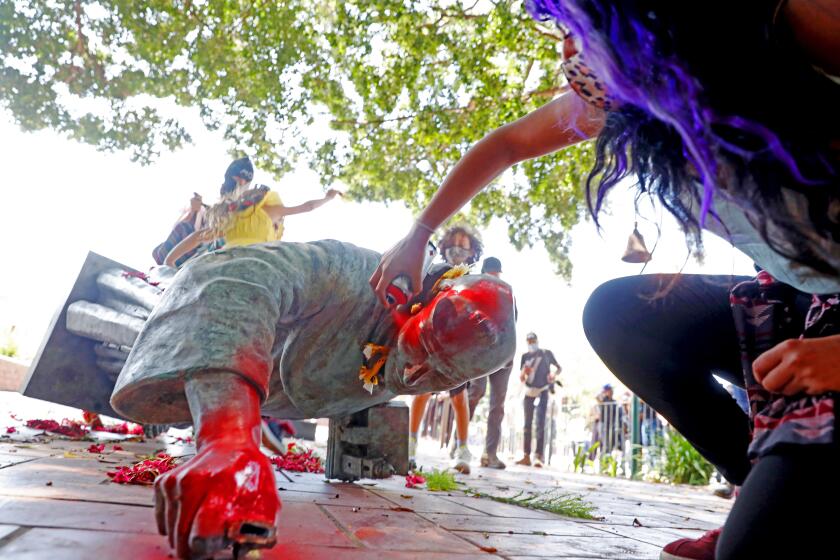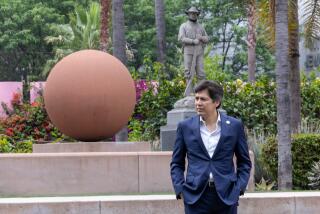Commentary: Goodbye, guy on a horse. A new wave of monument design is changing how we honor history
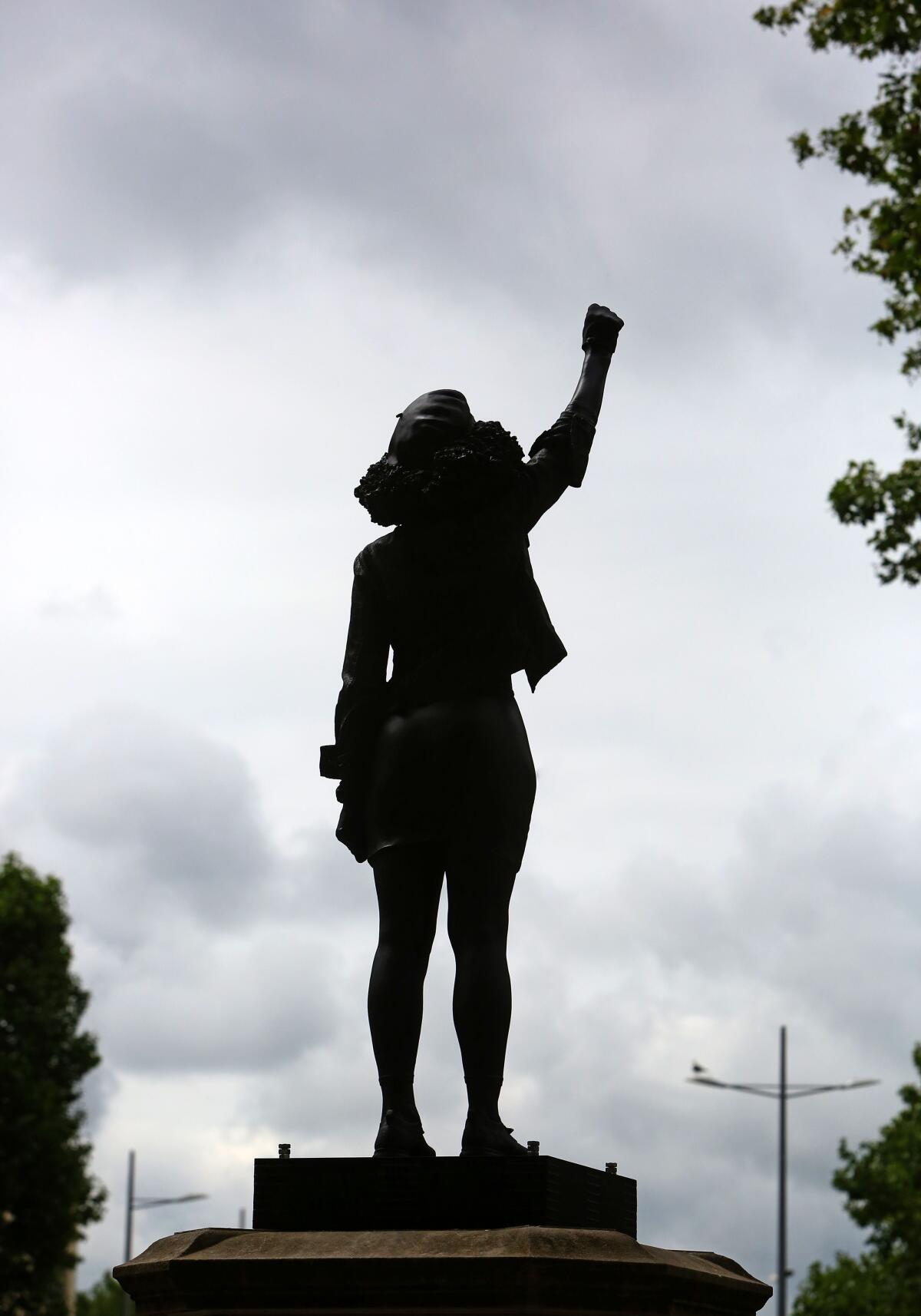
- Share via
Summer, 1942.
A group of Mexican youths gather for a birthday party at a popular swimming hole known as Sleepy Lagoon, named for a tune by big band trumpeter Harry James. Sleepy Lagoon, on the eastern banks of the Los Angeles River, is not a lagoon, but a quarry pit popular with Mexican kids in a time of segregation when the city’s public pools are generally off-limits to Mexicans, Blacks and Asians.
The party gets rolling. Another group crashes the scene. A fight breaks out. The next day, a young man turns up dead. And a night that started quite innocently launches a police crackdown on an epic scale.
Hundreds of young Mexicans are rounded up and arrested. Zoot suits are treated as a presumed marker of guilt. Twenty-two people, most of them minors, are charged, then tried en masse with limited access to lawyers or even clean clothes.
During the trial, an “expert” for the Sheriff’s Department testifies that Mexicans have a “desire to kill, or at least, let blood.” Despite an overwhelming lack of evidence, 12 people are convicted of murder and assault; five, on lesser charges. It is the largest mass conviction in California history.
Sleepy Lagoon was a pivotal moment in Los Angeles. Though the convictions were all ultimately overturned, the anti-Mexican sentiment generated by the roundups and the trial set the stage for the Zoot Suit Riots the following summer, when vigilante servicemen took to the streets in search of pachucos to brutalize.
Yet there is no civic monument to mark what Sleepy Lagoon wrought. Nor, for that matter, is there a marker for the Zoot Suit Riots — oversights that speak volumes about the histories our city considers worth honoring and those it has chosen to overlook.
That may soon change.
We are at a moment when monuments across the country and beyond these shores are coming down, some through official means and many others through the direct actions of protesters. Since the May 25 police killing of George Floyd in Minneapolis, more than 100 Confederate monuments or memorials — which function as the visual markers of Jim Crow — have been removed or scheduled for removal this year, some of them right here in California. It’s an acceleration of an ongoing movement. Thirty-six Confederate monuments came down in 2017, the year of the white supremacist rally in Charlottesville, Va.
More specific to our state’s history are the myriad representations of Junipero Serra, the Franciscan friar who helped establish the mission system, spaces intended to convert indigenous people to Catholicism, but which also functioned as punitive labor camps. Late last month, the statue of Serra that has stood in the environs of Olvera Street in downtown L.A. for almost a century was toppled by activists.
The removals of these statues invariably generate discussions about what will replace them — discussions arising at a moment when the nature of monuments, the processes by which they are built, and the histories they choose to honor are all in question.
End of the bronze age?
Here in Southern California, a group of artists and designers, spurred by the advocacy group East Yard Communities for Environmental Justice, has spent the last several years developing plans for a memorial that would give Sleepy Lagoon a space in the civic landscape.
The concept doesn’t call for a bronze statue plunked into some urban plaza. Instead, the design proposal, intended for Riverfront Park in Maywood — across the L.A. River from where Sleepy Lagoon was once located — weaves together a mix of design elements to tell a more complex tale about the intersecting social and environmental forces that led to that moment and the ones that came after.
“We didn’t want to fixate on the singular incident of a murder,” says Sandra de la Loza, an artist who is part of the design team and whose work has long explored L.A. histories that have been overlooked or erased. Instead, the aim is to recognize a cultural site that “came about in the context of 1940s — L.A. being a segregated city where Black and brown youth could not swim in pools.”
It’s history to which she has a personal connection. “My parents were Zoot suiters,” she says. “And in the subsequent sweeps ... my uncle was rounded up by police.”
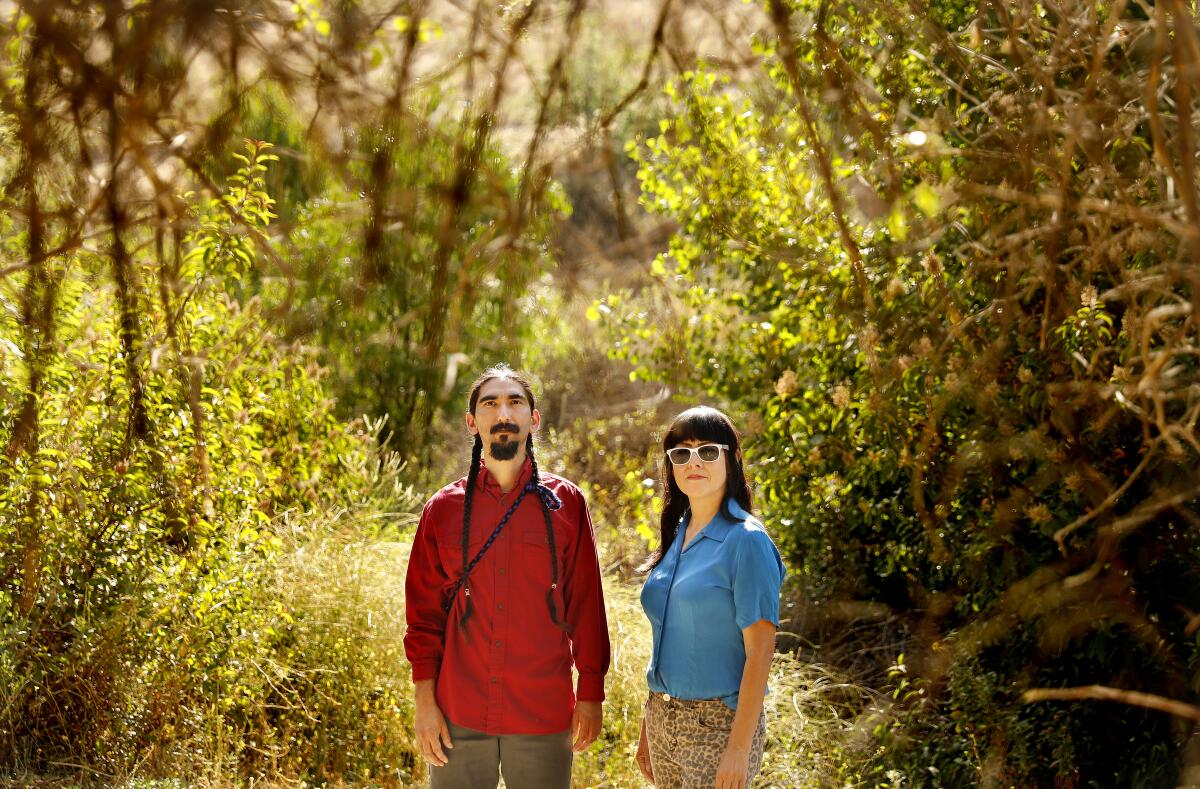
The design, conceived in collaboration with fellow artist Arturo Ernesto Romo and landscape architecture firm DakeLuna, features sculptural pieces embedded into a landscape that pay tribute to the youths who once frequented Sleepy Lagoon. It also channels the restful spirit of a swimming hole: a swale will capture water and visitors can shade themselves in a grove of native plants.
The broad nature of the memorial reflects the broad nature of the artists’ research, which includes extensive interviews and workshops with historians, community members, plant experts and Tongva cultural leaders — all undertaken in an attempt to understand every bit of the history and environment that shaped Sleepy Lagoon.
Before the beatings of Rodney King and Reginald Denny, there was Sleepy Lagoon.
“The incident at Sleepy Lagoon is born from a series of interrelated events,” says Romo, who, like De la Loza, also creates work that engages the history of Los Angeles (albeit in fictionalized ways). “To reduce an incident like that down to an individual thing, it doesn’t do justice to the way that any human experiences and events play out.
“We are moving away from what a monument traditionally is,” says De la Loza, “which is the pedestal with the military figure that constitutes a singular idea that upholds empire.”
Still, a statue can have formidable power.
Take the resin-and-steel statue that artist Marc Quinn illicitly installed on the empty plinth that until recently was occupied by a bronze statue of 17th century slave trader Edward Colston in Bristol, England. It features activist Jen Reid, fist raised, in honor of the moment during recent Black Lives Matter protests when Colston’s statue was toppled and Reid climbed atop the plinth in Colston’s stead.
The statue, titled “A Surge of Power (Jen Reid) 2020,” quickly became a potent image of change even after its removal by the city.
Yet this image of Black representation has also come under fire. Artist Thomas J. Price, who is currently finishing a commissioned bronze statue of a Black “everywoman” that will be erected in east London, was critical in the U.K. edition of GQ of “the ambition and entitlement of this very privileged white guy, this white artist, Marc Quinn.”
And though Reid participated in the making of Quinn’s statue, Price, who is Black, added: “It’s as if Quinn, by casting her in resin, and controlling her, is stealing that genuine moment away, claiming it as his own.”
It all could very well mark the swan song for the monument style we can call “guy on a horse.”
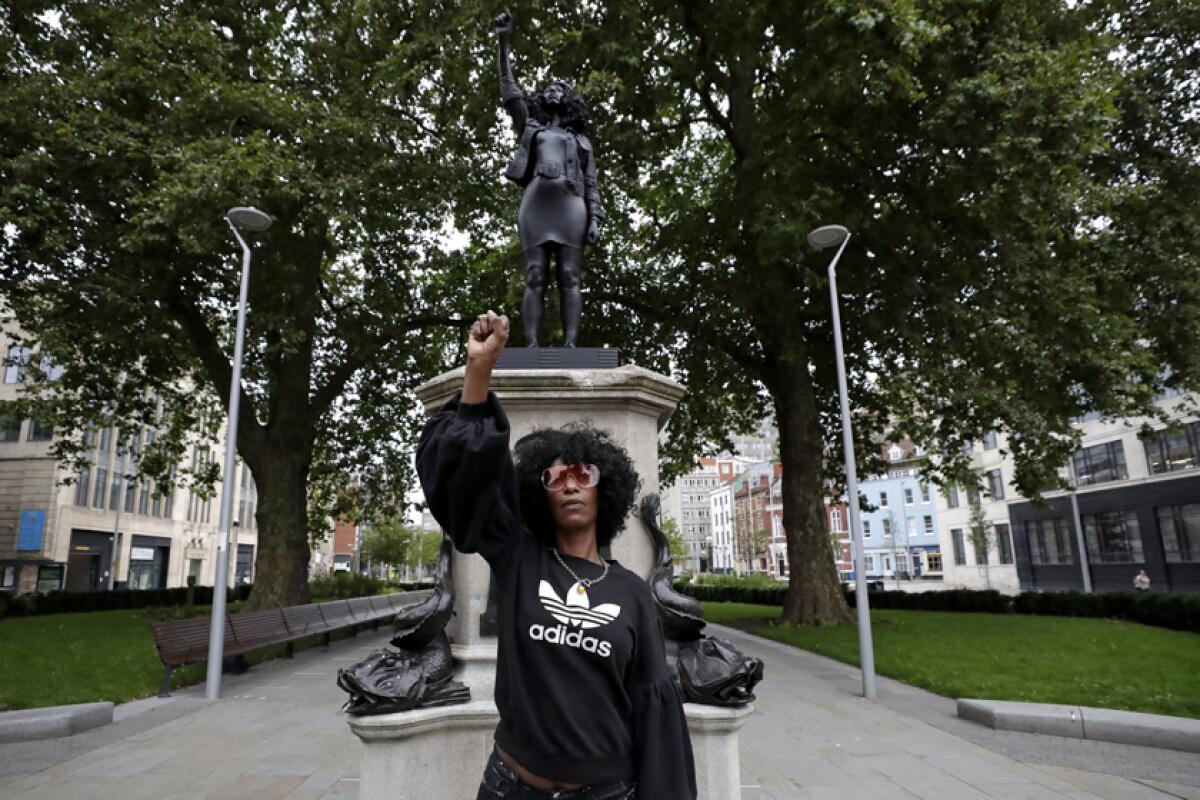
Monumental change
The aesthetic and political concerns of monuments are something that Monument Lab, an arts group founded by artist Ken Lum and scholar Paul Farber, both of the University of Pennsylvania, have been examining since 2012.
The traditional function of monuments “has been to activate or even sustain a certain narrative of memory which people of influence have deemed worthy or important to maintain,” Lum says. “They are mnemonic devices.”
And, in the U.S., they comes in various flavors — starting with guy on a horse, a form of honoring strength and military might that dates back to ancient Greece and Rome, as well as the countless statues, pillars, plaques and bas reliefs that honor historic figures and events in ways both literal and allegorical — and in forms that are largely drawn from Western European tradition.
Activists toppled a statue of Junipero Serra from its post at Placita Olvera in downtown Los Angeles on Saturday.
In recent decades, monuments such as Maya Lin‘s Vietnam Veterans Memorial in Washington, D.C., have helped usher in more abstracted land-art-style works that are more about setting a mood than putting up statues to individuals.
“Sometimes a monument becomes a monument by accident because people bestow meaning to it over time,” Lum says. “Say, the hulking steel remnant of an old building in Hiroshima, which wasn’t intended to be a monument but now functions as a memorial” to those killed by the atomic bomb.
But many monuments are built as incarnations of power.
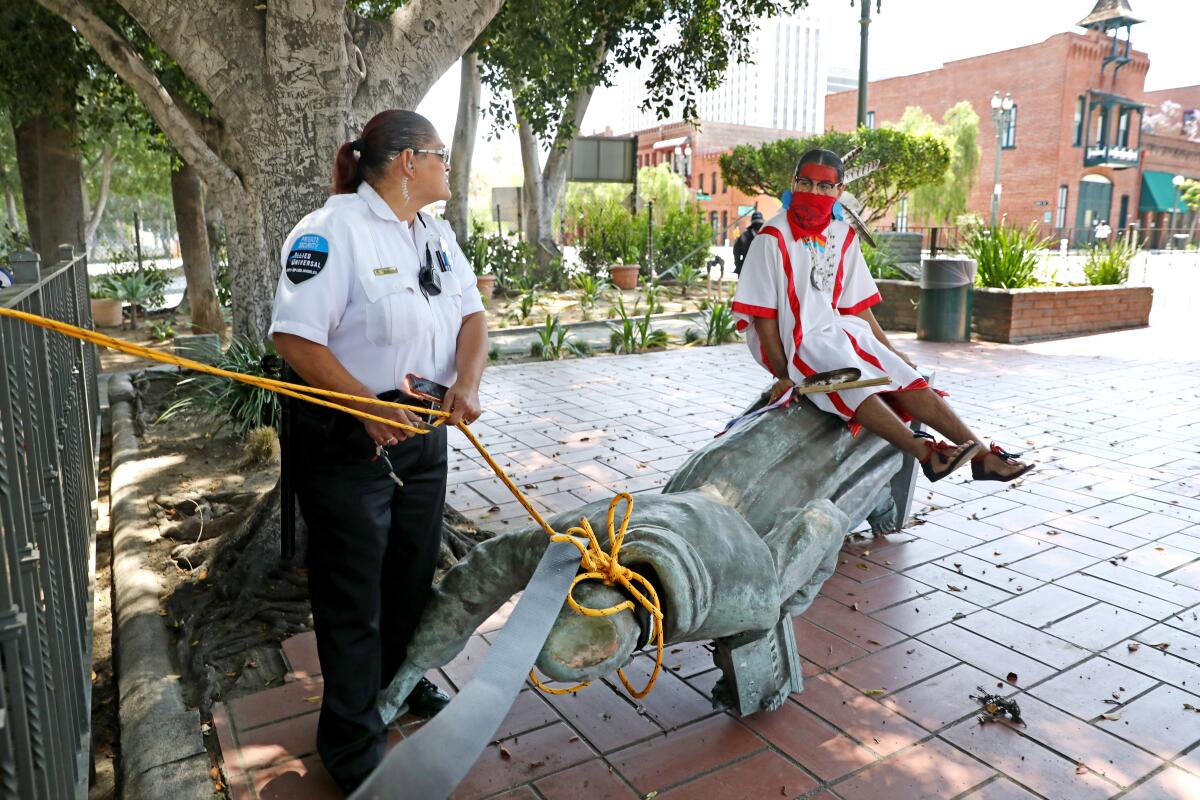
And in highlighting the history of the powerful, there are other histories — through purpose or inertia — that get overlooked.
In 2015, Lum and Farber organized an exhibition in Philadelphia that asked the public to pitch monument ideas for the city. Two years later, they staged an exhibition that placed temporary monuments around town. The interventions revealed gaping blind spots in the city’s civic memory.
“Here in Philadelphia, you have a lot of statuary of men,” Lum says. “There are only two full statues of women — not counting muses or fictional women — and neither is from Philadelphia. ... Until recently, there was no statue of an African American. This, in a city that was very important to the Underground Railroad route and the abolitionist movement.”
Other cities have also been taking a cold hard look at these issues: In 2018, San Francisco’s Board of Supervisors approved a measure that required greater representation of women in its public art collection. (At the time, only two of the Arts Commission’s 585 works were of nonfictional women.)
The city of L.A.’s outdoor art collection has five representations of real women out of a total of 178 works, according to the Department of Cultural Affairs.
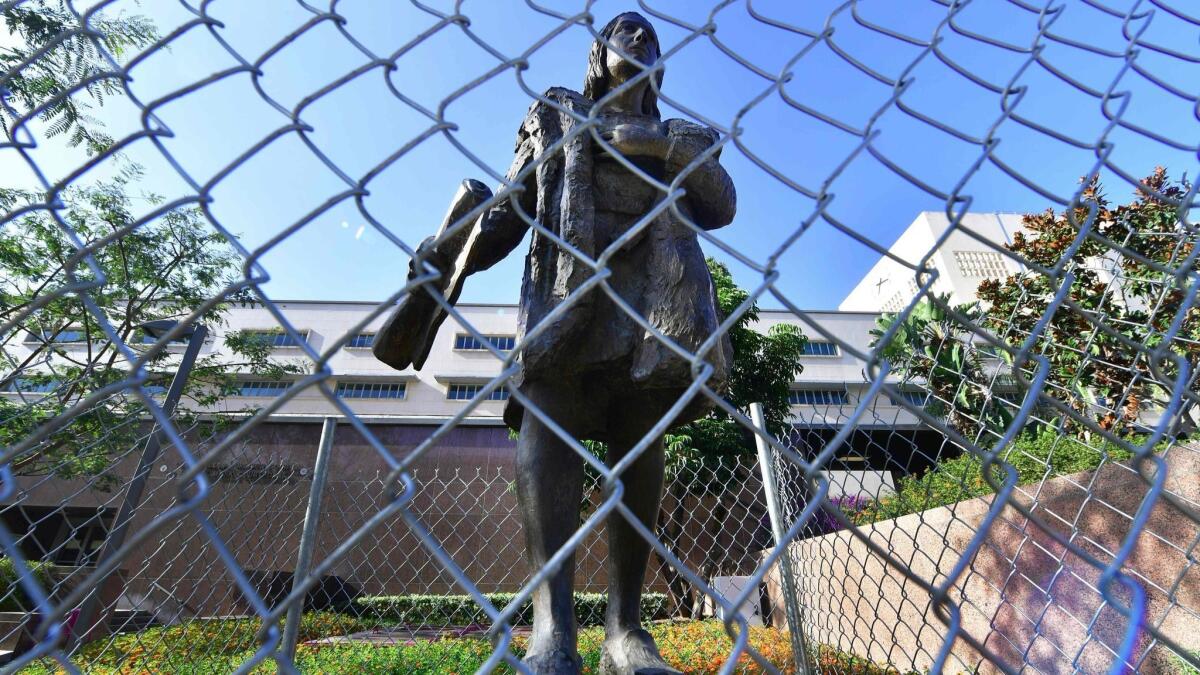
Last year, Monument Lab teamed with the Goethe-Institut and the German government to support a series of events and exhibitions around North America called “Shaping the Past,” intended to examine the ways in which cities memorialize their history. (Coronavirus has put the exhibitions on hold, though the conference portion of the program is expected to proceed digitally in the fall.)
“The idea is to ask questions about monuments and what a monument is and how it changes over time,” says Lien Heidenreich-Seleme, director of the Goethe-Institut, Los Angeles.
As part of this, the project is supporting artists and thinkers who are engaging the issue of monuments in cities across the U.S., Canada and Mexico.
Artist and organizer Joel Garcia is the program’s Los Angeles fellow — an involvement that arises out of his own years-long activism related to monuments. Garcia, who is of Huichol background, was part of a group of indigenous organizers who pressed the county of Los Angeles to remove a statue of Christopher Columbus that once stood in Grand Park.
After the statue came down in 2018, the informal discussion on social media frequently pivoted to what statue should replace it. But Garcia says the removal presented an opportunity to think bigger about what a monument to the indigenous experience might be.
“Maybe it’s thinking what we do with that space is letting it revert to its natural state,” he says. “Giving it back to the birds. Can we get the egrets to come back to L.A.? Maybe that is the biggest monument we can create.”
Garcia, in collaboration with artist River Garza, worked with the Los Angeles County Department of Arts and Culture and the county Native American Indian Commission to help develop a framework for how the county might begin to approach the space. That resulted in a request for proposals, released this month, that will select two teams of artists to create temporary, indigenous-centered works at the site.
“It’s not just us contesting Columbus, but a broader focus,” says Kristin Sakoda, director of the Department of Arts and Culture. “It’s about centering indigenous voices,”
The project could take the form of a temporary structure, an event or something land-based — in the process engaging various communities who together perhaps will generate a more long-lived idea for the site.
“It’s about expanding,” Sakoda says. “Artists have been pushing the needle and helping us understand that art is more than an object, and that goes for monuments.”
An 800-pound marker for the Jefferson Davis National Highway has been removed from view. A college student’s email prompted the change.
Ask the people
Rethinking monuments is something the city of Los Angeles is also engaged in. Last year, the city’s chief design officer, Christopher Hawthorne, assembled a working group to develop a process for evaluating current monuments and creating new ones.
“Some can come down, others should be protected,” says Hawthorne, who used to be this paper’s architecture critic. “Others we may want to reframe or recontextualize.”
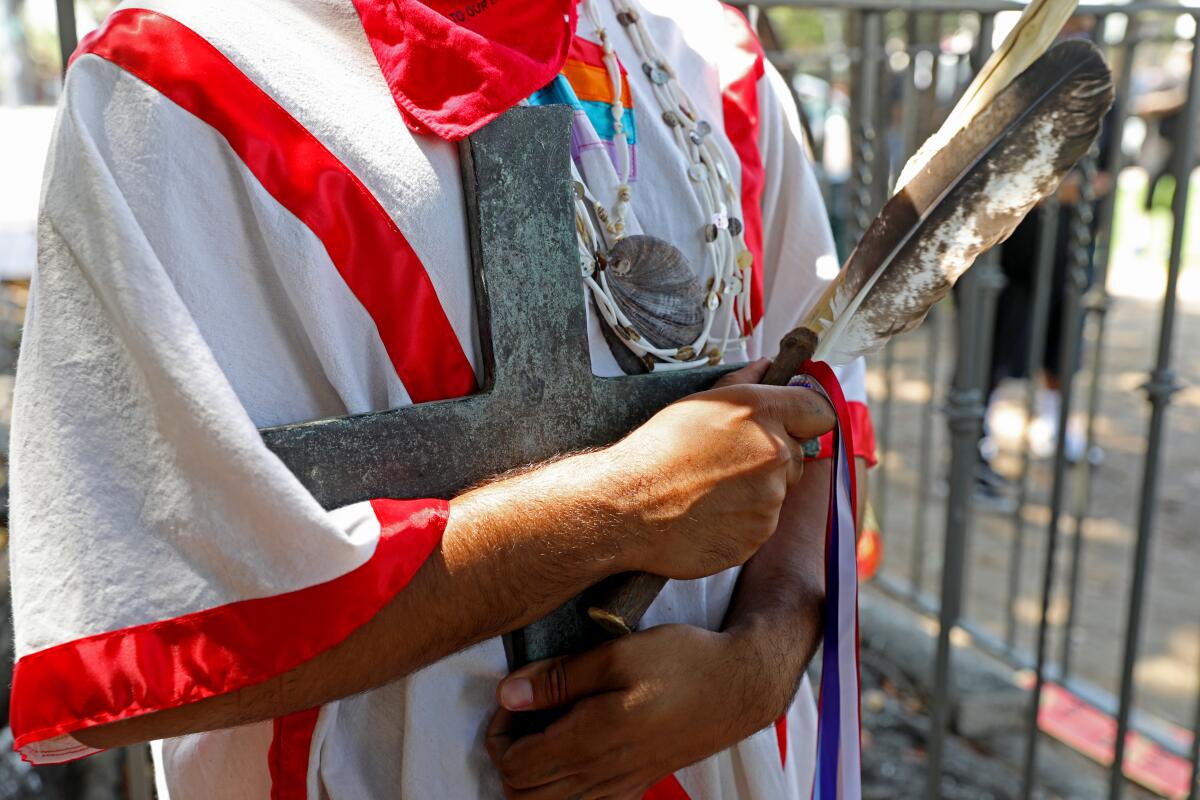
The aim isn’t to create hard rules about what monuments should look like or who should be honored, but instead provide a guide for how the city can develop monuments that speak to L.A.’s unique history and landscape.
“Some kind of distributed model for monuments would be great for Los Angeles given the way the city is organized,” Hawthorne says. “1992 is a good example — if we want to commemorate the uprising in some way, it’d have to be community generated and it could be a distributed set of responses.”
The working group, which is expected to produce a report by the end of the year, includes essayist D.J. Waldie, designer Rosten Woo, African American studies professor Kelly Lytle Hernández and Chicano studies professor Eric Avila, among several dozen other people.
Review: A powerful look at ‘The Chinatown War’
William Deverell, a history professor at USC and member of the L.A. working group, is one of many who say it’s time for the city to contend with the brutal murders of at least 17 Chinese men and boys (accounts vary from 17 to 20 dead) by a mob that also ransacked Los Angeles’ Chinatown in 1871.
“It’s one of the largest massacres of Chinese people in American history and it happened right here,” Deverell says. “This notion that we can just assign this to a Wild West past or that it was the 19th century and the rough-and-tumble era of the frontier, it doesn’t work. This is the origin point of modern Los Angeles. Right now, this event is marked by a plaque near the Chinese American Museum. That is an important act. But it ought to be marked in a more powerful way. A wider reckoning is called for.”
Expanding the aesthetic language of monuments is something that many designers have been working on.
Chicago architect Jeanne Gang and her firm, Studio Gang, have spent several years on design concepts for the Mississippi waterfront in Memphis. The six-mile site includes Cobblestone Landing, built in the 19th century to serve as an important port for cotton — a trade built on the labor of the enslaved. There have been ongoing discussions about how a site like this might be memorialized.
“It was an almost horizontal monument,” Gang says of the landing, “a place that could also somehow represent democracy and the people, and not have a figural statue standing on it.”
Her firm explored this idea for the 2018 Venice Architecture Biennale in an installation titled “Stone Stories.” Hundreds of cobblestones were assembled on the floor of the U.S. pavilion, accompanied by a wall piece that showed how stones might be shaped to tell individual stories — carved into the form of a hand or embedded with the relief of a ship.
“We wanted to integrate voices and memories into that space,” Gang says. “We started collecting the stories of people from different aspects of the community: an artist, a musician, a patron of the arts, a mayor, a chef. ... From the designer’s standpoint, the question was: Could we embed their stories into the material — into the stone.”
At the core of the conceptual piece — intended to prompt a dialogue about making a remembrance of a site such as Cobblestone Landing feel more contemporary, less 19th century — is community involvement. That’s a critical component in how monuments are now being designed and built. As opposed to civic leaders a century or more ago, who would throw up monuments with little debate, or President Trump, who wants to build a so-called National Garden of American Heroes, an idea that shows little effort to engage the public in any sort of dialogue about who those heroes might be — or how they might be rendered.
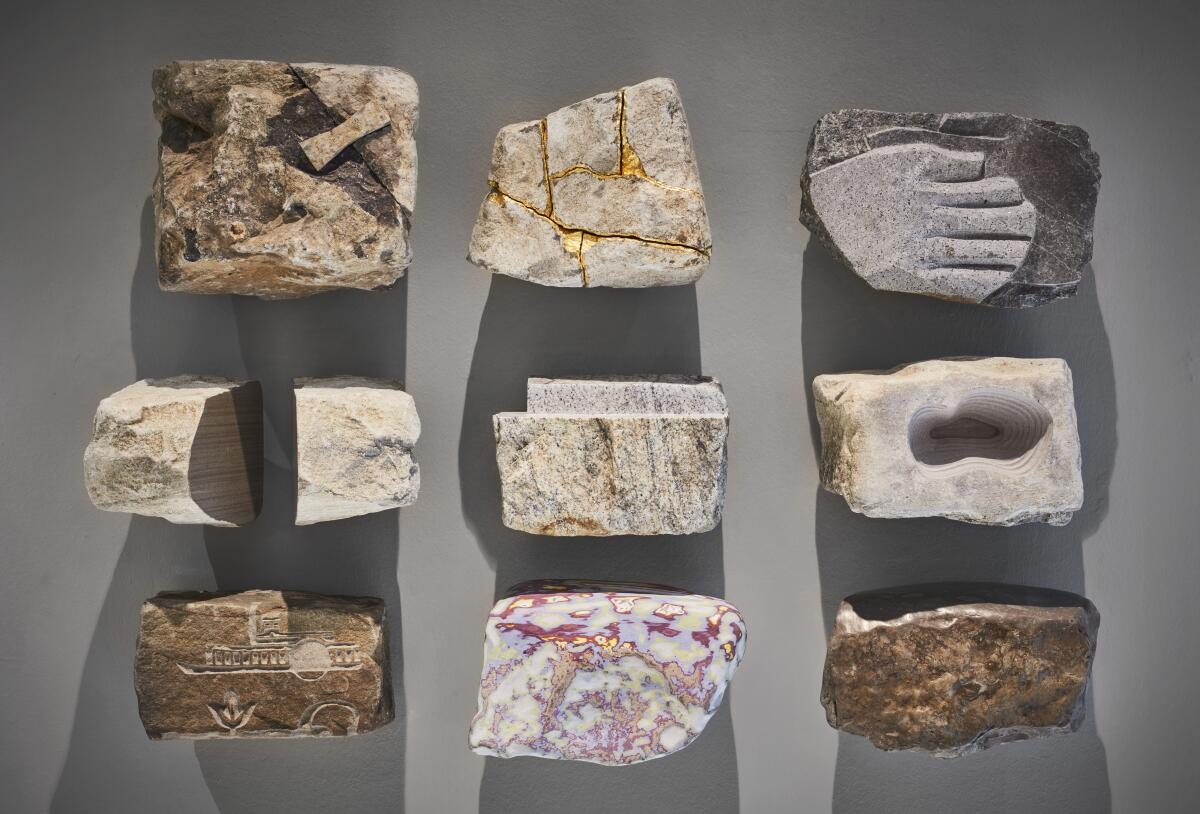
Naturally, these more collective design processes are not without friction.
In San Francisco, wrangling over design caused a proposed monument to Maya Angelou to be scrapped late last year. In New York, a muddled process over monuments for the city has left artists, designers and community participants frustrated about their voice in the process.
But this collective design process — messy as it is — can produce poignant works.
Over the last decade, faculty, staff and students at the University of Virginia (UVA) have pushed the school to address its legacy of slavery. The school was founded by a slaveholder: Thomas Jefferson. In addition, an estimated 4,000 enslaved persons worked at the university between its foundation in 1817 and the end of the Civil War in 1865.
One of the ways in which UVA is reckoning with this legacy is through a new Memorial to Enslaved Laborers — on which construction has been completed, though no formal dedication has taken place because of the pandemic. (It was, however, informally inaugurated last month when a stirring protest in honor of Black Lives Matter took place at the site.)
Protests against racism after the killing of George Floyd demonstrate inequities in public space too often designed for white people. How to change that.
Designed by Boston-based architects Höweler + Yoon, in collaboration with scholar and architect Mabel O. Wilson, landscape architect Gregg Bleam and UVA faculty member Frank Dukes, it consists of a somber circle of granite that is open on one end. Carved into the interior are the known names of enslaved laborers; those who remain unknown are acknowledge with a mark.
The exterior features a pair of eyes designed by New York-based artist Eto Otitigbe, taken from a portrait of Isabella Gibbons, an enslaved woman who labored at the university and who, after emancipation, went on to become a teacher. Her eyes are carved in such a way so as to be visible only at certain angles or in certain light.
It is a monument that, quite literally, requires the viewer to meet its gaze.
Otitigbe says that the dialogues that took place before to the monument’s construction allowed community members, historians and, most important, descendants of the enslaved, to be seen and heard. “It was fostering a communication about what makes up the rich culture or history of a community,” he says.
It also created lasting bonds. He remembers one meeting at which a descendant came forward and passed him a photocopied form. “It was a copy of, I think, her great great grandfather’s manumission papers.”
“You know,” Otitigbe says, “we go to the city clerk’s office for parking tickets or to pay our taxes or get a deed to a house, but this showed how ingrained slavery is in our country — that you can go to a city clerk and get these documents that were about the enslavement of others.”
Sacred ground
Cameron Shaw, the deputy director and chief curator at the California African American Museum, sees strength in inclusiveness, especially in Los Angeles.
“When I start to think about the types of monuments that interest me, it’s the collective ancestor altar. That is a form known by Angelenos: a public, large-scale site where people can honor the people who came before us, the native land, the people who came after,” she says. “That’s something we see throughout the city and because of celebrations like Día de los Muertos, it’s very familiar. In my mind’s eye, it has photographs, it has screens that play images of folks’ ancestors, multiple artists contribute to the vision, and there is a pilgrimage piece in which Angelenos can come from all over and contribute many different images and many different rituals.”
Monuments may have historically functioned as manifestations of power, but increasingly they are places where collective memories are recorded and sacred ground marked — even when that ground has shifted over time.
The Southern California site where Sleepy Lagoon was located has been paved over by warehouses, residing somewhere around the present-day boundary between Maywood and Bell, just north of Slauson Avenue and east of the 710.
Boundaries are something that the memorial’s designers have been steadily mulling over. Social boundaries. Political boundaries. Racial boundaries.
“Pachucas crossing boundaries and challenging traditional patriarchal roles,” Romo explains. “Pachucos and pachucas crossing violently enforced racial boundaries in Los Angeles. ... Youth culture and its ability to explode boundaries and create a lasting impact on this kind of rebellious question of liberation.”
To examine these questions, they hope to create a landscape of quiet contemplation.
“We wanted to think of the memorial as a green space,” De la Loza says. “It’s about creating a restorative quality.”
In other words, a different kind of monument.
Says De la Loza: “This is a reclamation.”
More to Read
The biggest entertainment stories
Get our big stories about Hollywood, film, television, music, arts, culture and more right in your inbox as soon as they publish.
You may occasionally receive promotional content from the Los Angeles Times.
